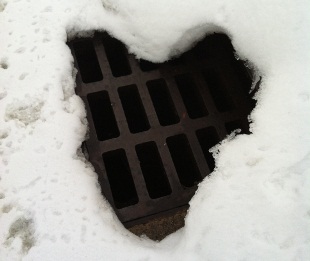 It is cold outside and if this winter is anything like last winter, it will get colder. And snowier. And have more ice. More than ever, your water (frozen and liquid) needs protecting! Water can get polluted easily in the winter months especially from snow and ice removal by using de-icers. Snow and ice melting products, known as de-icers, can have negative environmental impacts when melted snow and ice carry the chemical to our ditches, streams and rivers. Overuse of certain products, such as salts, can also damage driveways and vehicles, and can be a hazard for pets. Not all de-icing products are equal in terms of cost, environmental impact or effectiveness. What can you do?
It is cold outside and if this winter is anything like last winter, it will get colder. And snowier. And have more ice. More than ever, your water (frozen and liquid) needs protecting! Water can get polluted easily in the winter months especially from snow and ice removal by using de-icers. Snow and ice melting products, known as de-icers, can have negative environmental impacts when melted snow and ice carry the chemical to our ditches, streams and rivers. Overuse of certain products, such as salts, can also damage driveways and vehicles, and can be a hazard for pets. Not all de-icing products are equal in terms of cost, environmental impact or effectiveness. What can you do?
1. Shovel early, shovel often. De-icers work best when there is only a thin layer of snow or ice that must be melted. Remove as much snow as you can during the storm if possible. Use a hoe or other tool to scrape or chip off ice from the surface before de-icers are applied.
2. If you have a chronic problem with ice forming, determine the source and divert the melting snow away from your sidewalks and driveways to an area where the ice won’t be a problem.
3. Shovel early in the day, the sun will warm the surface and help melt new snow and prevent the need for de-icers.
4. Shovel or plow your driveway and sidewalks before spreading de-icer.
5. Shovel before you drive a vehicle on the driveway to reduce packed snow.
6. Limit the use of de-icers, especially those with the most negative impacts.
7. Make sure to purchase your de-icing product well before the storm hits. Otherwise, you will be looking at empty shelves, and have few, if any, environmental choices to make at the store.
8. Many de-icers will not work in extremely low temperatures. Make sure you are getting the correct product for the situation.
9. Do not use fertilizers for snow and ice removal. Fertilizers are very poor at ice melting and removal and increase nutrient runoff to streams.
10. Do not try to use sand to melt snow or ice. It will only increase traction, which can be very helpful in certain situations.
Remember that when the snow and ice melt, it carries everything along into the nearest ditch or stream, often via storm drains. The chemicals you pour on your sidewalks can have detrimental effects on nearby plants, animals and water systems. Think carefully about nearby kids, pets and landscaping that could be affected by the de-icing products. Keep your own safety in mind. Our waterways are our drinking sources. Your rivers will thank you when the snow and ice melt.
Information was provided by Snow, Road, Salt and the Chesapeake Bay by Tom Shuler, Center for Watershed Protect. For more information, check out the Salt article at http://danedocs.countyofdane.com/webdocs/pdf/lwrd/lakes/Salt_Article.pdf
